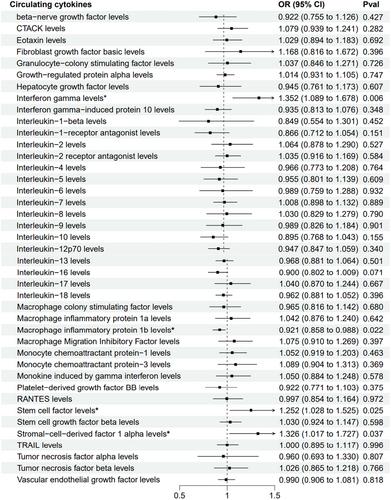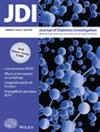A Mendelian randomization study on the causal association of circulating cytokines with diabetic nephropathy
Abstract
Background
Circulating cytokines were reported to be related to diabetic nephropathy (DN) in observational studies. However, the causal relationship between them remains unknown. This study aimed to investigate the causal relationship between DN and circulating cytokines with genetic data in the frame of Mendelian Randomization (MR).
Methods
We performed a two-sample MR analysis to investigate the causal relationship in individuals of European ancestry, utilizing publicly available genome-wide association study (GWAS) statistics. We selected eligible instrumental SNPs that were significantly related to the circulating cytokines. Multiple MR analysis approaches were employed, including inverse variance weighted (IVW), Weighted Median, MR-Egger, Weighted Mode, Simple Mode, and MR pleiotropy residual sum and outlier (MR-PRESSO) methods.
Results
We found evidence supporting the causal role of genetically predicted circulating levels in the increased risk of DN. Specifically, we observed associations for interferon-gamma [OR = 1.352, 95% CI: 1.089–1.678, P = 0.006], stem cell factor [OR = 1.252, 95% CI: 1.028–1.525, P = 0.025], and stromal-cell-derived factor 1 alpha [OR = 1.326, 95% CI: 1.017–1.727, P = 0.037]. Additionally, MR analysis revealed a negative causal association between macrophage inflammatory protein 1b and DN [OR = 0.921, 95% CI: 0.858–0.988, P = 0.022]. The results obtained from MR-Egger, Weighted Median, Weighted Mode, and Simple Mode methods were consistent with the Inverse Variance Weighted (IVW) estimates. Sensitivity analyses showed no evidence of horizontal pleiotropy, suggesting that the causal estimates were not biased.
Conclusions
Our findings offer promising leads for developing novel therapeutic targets for DN. By identifying the role of inflammatory cytokines in this debilitating condition through a genetic epidemiological approach, our study made contributions to a better understanding of the underlying disease mechanisms.


 求助内容:
求助内容: 应助结果提醒方式:
应助结果提醒方式:


